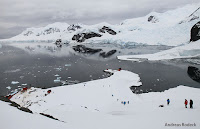 On our last night of sailing south in the Drake Passage, we began to feel the ship moving a little more than we were used to. By morning, the sea had built up a good swell and it kept building for most of the day! The captain closed portions of the deck for security reasons, but inside we were warm, dry, and mostly comfortable(!) As we sailed by the South Shetland Islands, brash ice and icebergs passed by the good ship Fram, and one in particular caught our eye as the big waves crashed against and over it. The South Shetland Islands also passed us by but the foggy conditions prevented good views. We somehow felt near and far from Antarctica at the same time.
On our last night of sailing south in the Drake Passage, we began to feel the ship moving a little more than we were used to. By morning, the sea had built up a good swell and it kept building for most of the day! The captain closed portions of the deck for security reasons, but inside we were warm, dry, and mostly comfortable(!) As we sailed by the South Shetland Islands, brash ice and icebergs passed by the good ship Fram, and one in particular caught our eye as the big waves crashed against and over it. The South Shetland Islands also passed us by but the foggy conditions prevented good views. We somehow felt near and far from Antarctica at the same time.The weather system (an area of low pressure) causing the conditions we experienced today was situated right over us and prevented our first planned landing at Half Moon Island. We hope to have a chance to visit on our way back north in a few days. We expect the conditions to improve for the rest of our precious time in Antarctica. In preparation for our landings we gave everyone their mandatory IAATO (www.iaato.org) briefing on conduct in Antarctica, and fitted their life-jackets.

In the morning some of our Polar Cirkle boat groups had a chance to visit the bridge, where Capt. Rune Andreassen was on watch. He explained the workings of the "brain" of the Fram (the engine room is the "muscle"!) and fielded many questions from interested passengers. For many it was the first time they had ever set foot on a ship's bridge, let alone one so sophisticated as the Fram's.

And finally, a big Hi from grandparents and all of us on the Fram to APDS, 4th Grade! Hope you are enjoying the blog!















































